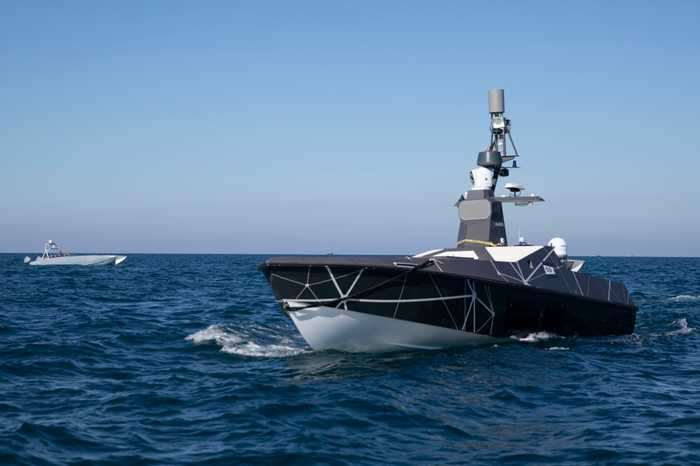Published 18:38 IST, November 5th 2024
India Making Strides in Autonomous Maritime Security with Matangi USV’s 350 Nautical Miles Journey
Matangi's successful transit highlights the strategic importance of autonomous surface vessels (USVs) in modern military operations.
- Defence
- 4 min read
Mumbai, India – The Indian Navy’s ambitious "Sagarmala Parikrama" mission, which aims to showcase India's technological prowess in autonomous naval engineering, reached a major milestone as the autonomous surface vessel Matangi successfully completed the first leg of its sea passage from Mumbai to Karwar. The vessel’s journey, covering approximately 600 kilometers (350 nautical miles), is a testament to the cutting-edge capabilities of India’s maritime innovation spearheaded by indigenous startups and MSMEs.
Flagged off on October 29, 2024, during the Swavlamban 2024 event by Defence Minister Rajnath Singh , the Matangi is on an autonomous transit mission that spans a distance of 850 nautical miles (1500 kilometers) from Mumbai to Tuticorin. Equipped with India’s indigenous "navigation & collision avoidance software," Matangi operates entirely without human intervention, setting a pioneering example for maritime autonomy. This technological breakthrough was achieved by Sagar Defence Engineering, an emerging leader in India’s defense-tech space, showcasing the nation's dedication to innovation and self-reliance under the Atmanirbhar Bharat initiative.
The project reflects India's commitment to harnessing indigenous technology in defense, paving the way for applications that could revolutionize naval warfare, maritime security, and surveillance. As Matangi continues its journey, this autonomous vessel demonstrates India's growing technological sophistication, aligning with the spirit of Swavlamban 2024, which underscores "strength and power through innovation and indigenization."
Strategic Importance of Autonomous Surface Vessels (USVs)
Autonomous surface vessels like Matangi hold strategic importance for modern military operations, which increasingly rely on precision, resilience, and adaptability. In today’s complex geopolitical environment, USVs serve multiple critical roles across diverse military domains. USVs are vital in intelligence-gathering, especially in high-risk or inaccessible areas.
-1730810726113.webp)
Autonomous surveillance helps monitor contested waters, as seen in the Russia-Ukraine conflict, where both sides use unmanned platforms for reconnaissance in the Black Sea. Equipped with advanced sensors, cameras, and radars, these vessels can autonomously scan vast areas, capturing real-time data crucial for military operations.
Maritime Security and Anti-Submarine Warfare (ASW)
As naval tensions escalate worldwide, particularly in strategic areas like the South China Sea, USVs are increasingly deployed for ASW missions. Equipped with sonar and anti-submarine systems, these vessels collaborate with other manned and unmanned platforms to identify and monitor underwater threats, reducing risk to human operators while maintaining comprehensive surveillance of maritime chokepoints.
-1730811198581.webp)
USVs can function as mobile relays, supporting stable communications in geographically dispersed naval operations. This capability is crucial in areas such as the Gulf, where USVs like the Sea Hunter act as relays for naval units, enabling coordinated operations even in areas with disrupted communications.
Mine countermeasures are essential in conflict-prone waters where naval mines pose significant risks to manned vessels. In regions like the Persian Gulf, USVs equipped with sonar and AI-based classification systems autonomously detect and neutralize mines, ensuring safer passage for larger ships. This role reduces the exposure of human personnel to high-risk mine-clearing operations.
Precision Strike Capability
As demonstrated in recent conflicts, USVs can be modified for offensive capabilities, including precision strikes on naval assets. Ukraine’s deployment of explosive-laden USVs to target Russian vessels highlights the strategic value of these platforms. Equipped with stealthy navigation and payload delivery systems, they represent a low-profile yet impactful option for disrupting adversary naval assets.

ISTAR capabilities are increasingly vital in modern conflicts, where situational awareness is critical. The Chinese Navy’s deployment of USVs in the Taiwan Strait underscores their effectiveness in real-time intelligence gathering. Equipped with high-endurance sensors and secure data transmission, these platforms relay actionable intelligence to command centers, helping keep adversarial actions in check.
Updated 18:38 IST, November 5th 2024